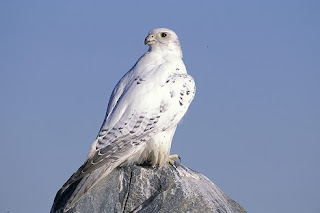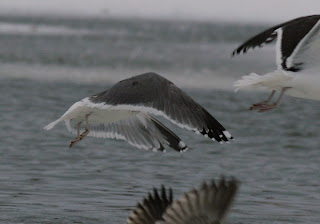Things got off with a bang on December 1st, when I discovered the provinces 2nd ever Black-tailed Gull at the sewage outfall in downtown St.John's.



later that same day a Slaty-backed Gull was discovered at Quidi Vidi lake. Slaty-backs are annual in St.John's now and along with California, St.John's is probably the msot reliable place to see this species outside of Alaska!! Just last week I discovered a second Slaty-backed Gull at the St.John's landfill, unofrtunately it was far away and behind a chain linked fence, but definitely a different bird based on it's bright yellow bill.

Rounding out the gull action on December 1st were a Yellow-legged Gull and an adult Thayer's Gull,to make for a 14 species gull day in the city.


About a week later the Lapwings started to arrive. During the last half of November through december Western Europe was experiencing extreme winter conditions with heavy snow fall and freezing conditions. In an effort to escape the sudden onset of winter many birds began to migrate from the Nothern UK ad other parts of western Europe into the southern most parts of the UL, France and probably Spain. When this happens we know there is potential for some birds such as Lapwings ( a common cold weather migrant) to turn up in Eastern Newfoundland. It`s hard to put a final tally on the number of Lappers we had in Newfoundland, but I`d guess it was at least 7-10 and probably many more that went unseen. Lapwings were seen off and on until late January.
As we were getting excited by the Lapwing arrivals news broke about a GREYLAG GOOSE that was photographed 180 miles off the NE coast of the island. This represents the second record for Newfoundland (the other on an offshore oil patform a couple years ago)and perhaps only the third for North America. Just a few days later Cliff Doran(Cape Race light keeper) found an Upland Sandpiper at Trepassey. UPSA is a big time rarity in Newfoundland and is practically unheard of in North America in December, aside from maybe a few records in teh some of the more southerly regions of the US. Over the next couple of week we kept ourselves busy looking for Lapwings when suddenly during the last few days of December Killdeer stared to arrive.
Now these were not migrants. Killdeers are not normally found within about 700+ miles of Newfoundland in winter, not to mention being uncommon in all seasons in the province. There were 56 seen on the Cape Race CBC alone. There must have been many hundreds in the province. Unfortunately all seem to have perished as of late February.
Just when we figured things wre about as good as they were going to get news broke on the Anna's Humingbird. Now, this was totally insane. The bird as visiting a hummingbird feeder in teh small community of Brownsdale, Trinty Bay, NW of St.John`s. Although this was completely shocking the record does make sense, since there has been a movement of Anna`s Hummingbirds into the east this winter, with several states and provinces getting their first or 2nd records including, Ontario, Quebec,Pennsylvania and North Carolina.

Photo by Jared Clarke
As January came to end we moved in the doldrums of winter. Well thats what would ahve happened ina normal year, but this year was anything but normal. February turned out to be one of the msot exciting months I've experienced in my dozen years of serious birding in Newfoundland. The month was kicked off with a Common Moorhen. After some careful evaluation it was determined that the bird was most likley a American Common Moohen, although we will never know for sure.

Photo by Jared Clarke
Hot on the heels of the Moorhen came the third North American mega-raity of the winter in the form of a Common Chaffinch. As I wrote earlier there are very few "good" records of Common Chaffinch in North America but we felt this bird was a genuine vagrant.

Not long after the Chaffinch, the Redwing reports started. Well there were actually 3 or 4 individuals, including one that seems to have hung around Portugal Cove South for about three weeks. There were probably more Redwings that went unseen. We generally find Redwing among Robin flocks feeding on Mountain Ash berries. This year there were essentially no Mountain Ash, or Dogberries as we call them, so the Robins were spread out feeding on Cranberries and Patridge berries on the barrens, making it much harder to sort through them and consequently more difficult to find vagrant Thrushes that might be hiding among them.


While Redwings are exciting birds and a huge rarity for most North American birders and in fact Newfoundland is about the the only place in North America where a birder would get more excited over a Long-eared Owl than a Redwing. That was exactly the case for myself and two other birders as we made our way home froma day birding on the southern Avalon in mid February. Long-eared owl is extremely rare in Newfoundland, with just three records. The bird we had in Ferryland was the first to have been seen in the wild by Newfoundland birders. The others were found injured.
Thw LEOW was a great bird and a major Newfoundland rarity, but not of great significance to North American birders, since they are relatively common across much of the continent. However, something much bigger was about to happen. Whil out looking for the LWOW on February 14th a local birder found a small group of three Snipe feeding in small puddle of open water. He photographed them briefly and moved on. It was not until he looked at the photos 6 days later that he realized that one of those Snipe was a JACK SNIPE!!!
Before news broke on the Jack Snipe Newfoundland birders were already in Snipe hunting mode because we had discovered seeral COMMON SNIPE. Common Snipe had been recorded in eastern North America only once previously and that was a single specimen collected in Labrador in 1927. Coincidentaly that year Newfoundland saw
1000's of Northern Lapwings, which were no doubt fleeing unusually bad weather in western Europe.


Aside from all the rarities there has been plenty of good winter birding in Newfoundland as well. We are startin to see good szed flocks of Common Eiders, including a few Kings. There are goodnumbers of Purple Sandpipers present and finches are beginning to stage a bit of an influx. Earlier in teh winter there were moderate numners of Dovekies t be found, which was nice after their inexplicable absence last winter. Throw in a bit of an ivasion of Boreal and Northern Saw-whet Owls into St.John's in February and that tops off a great winter of birding in one of North America's premier birding destinations!
NOTE I will be offering Newfoundland Winter birding tour next January, 2019. We will focus on rare gulls, finches and European rarities. Some highlight birds may include, Yellow-legged Gull, Common Snipe, Tufted Duck, Common Teal, Common Gull, Black-headed Gull, Eurasian Wigeon, Dovekie, Great Cormorant, King Eider (nice flocks of sea ducks in general), Pine Grosbeak, White-winged Crossbill, Boreal Chickadee, Willow Ptarmigan, Snowy Owl etc!





































